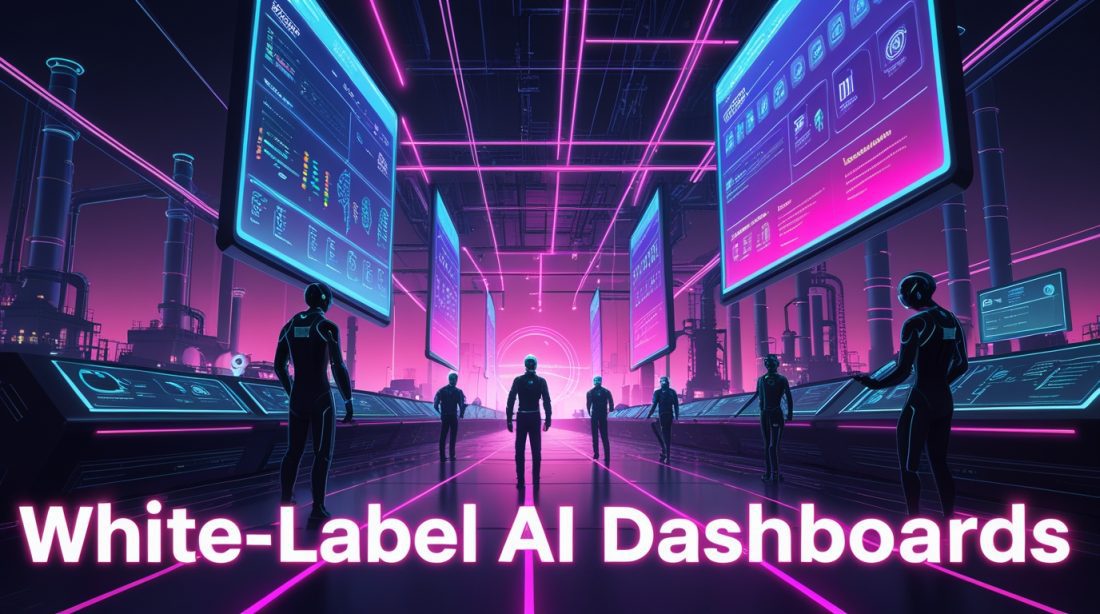The global industrial AI market is surging, creating a massive, high-margin channel for vendors and OEMs savvy enough to partner effectively.
Executive Summary
The white-label AI dashboard for OEMs market is exploding, driven by a CEO-level push for AI strategy in industrial sectors. These partnerships are not just about branding; they’re about integrating specialized AI into familiar operational environments. For OEMs, it’s a path to quickly enhance product value, while for AI vendors, it’s a scalable channel to reach lucrative industrial clients.
The $153 Billion Opportunity: How White-Label AI Dashboards Are Reshaping Industrial Markets
The most successful revenue sharing models for embedded analytics are moving beyond simple royalties toward value-based pricing in white-label analytics, tied directly to the significant ROI these dashboards deliver, such as the €270 million in savings Renault reported from predictive maintenance dashboards. For insights into how predictive maintenance is transforming factory efficiency, explore how AI boosts predictive maintenance ROI in 2025.
It’s 7:00 AM on a factory floor in Stuttgart, and Maria, a plant manager with 20 years of experience, isn’t staring at a wall of disconnected monitors. Instead, she opens a single, clean AI dashboard for manufacturing that bears the logo of the heavy machinery she’s operated for decades. This seamless experience is powered by a custom AI dashboard for industrial equipment, the result of a white-label AI partner program between a vendor and an OEM.
This is the reality of the white-label AI dashboard revolution. In 2025, as the industrial AI market growth 2025 pushes the sector toward an anticipated $153.9 billion, the question for businesses is no longer if they should adopt AI, but how. Companies leveraging platforms like SingularityNET’s industrial AI marketplace are already capitalizing on this trend.
Why the Industrial Sector is Ripe for White-Label AI
Industrial AI is built differently than consumer AI. From industrial IoT dashboard solutions to AI for predictive maintenance, OEMs need embedded, specialized, and reliable platforms. These capabilities are why more companies are considering white-label AI software development instead of building in-house. For a deeper dive into the platforms driving this transformation, check out this comparison of top industrial IoT platforms for smart factories.
The demand for seamless integration is clear. According to a report by McKinsey & Company, industrial AI adoption is accelerating as companies seek solutions that integrate with existing workflows without requiring extensive retraining.
The CEO-Driven Mandate for AI
By 2025, most large manufacturers have developed formal, CEO-driven AI strategies. This top-down demand is fueling adoption of white-label AI for manufacturing industry solutions, enabling OEMs to embed intelligence directly into their equipment. This shift is also evident in the rise of industrial AI and digital twins transforming industries, which highlights how integrated AI solutions are reshaping factory operations.
The ROI is No Longer Theoretical
From white-label AI for energy management to white-label AI for quality control, ROI has been proven across industries. Renault saved €270 million through predictive AI, while Georgia-Pacific captured hundreds of millions in value. These outcomes validate white-label embedded analytics guides for OEMs seeking scalable strategies. For example, Bosch’s predictive maintenance savings with AI showcase how targeted AI dashboards drive measurable financial gains. Additionally, a Gartner study predicts that industrial AI spending will grow at a 25% CAGR through 2030, underscoring the tangible value of these solutions.
How Revenue Sharing Models Work in White-Label AI Partnerships
The financial backbone of these partnerships is the OEM channel sales strategy for AI, built on shared incentives. Learn more about how these strategies are driving profitability in why industrial AI implementation wins big in 2025 factories.
- Royalty Model: Recurring payments based on usage.
- Value-Based Revenue Share: Splits tied to performance.
- Tiered Pricing: Upsells like multi-tenant analytics platforms or AI-powered BI tools for SaaS generate shared revenue.
Forward-thinking firms also co-develop, creating white-label AI platform features tailored to unique industrial needs. This collaborative approach is revolutionizing industries, as seen in how industrial AI agents slash energy costs in manufacturing.
Why OEMs Are Betting Big on White-Label Solutions
For OEMs, launching white-label analytics for SaaS companies or industrial dashboards is faster than building from scratch. Benefits include:
- Speed to Market: Launch in months.
- Enhanced Brand Value: Sticky ecosystems with subscription revenue.
- Recurring Revenue Models: Highlighted in white-label AI profitability case studies.
These advantages align with the broader trend of why robot subscription services are the next big revenue stream, showing how subscription-based models are reshaping industrial AI economics.
Why AI Vendors are Embracing the OEM Channel
For vendors, the OEM channel provides scaled access, predictable income, and white-label AI vendor selection advantages. This channel strategy strengthens white-label AI dashboard providers while enabling growth across industrial automation. The rise of edge AI vs. cloud AI for industrial optimization further illustrates how vendors are leveraging these partnerships to deliver real-time, scalable solutions. A Forbes article highlights how vendors are using white-label strategies to penetrate new markets efficiently.
The Future of White-Label AI Dashboards: Beyond the Dashboard
Next-gen dashboards will integrate:
- White-label AI for industrial automation and robotics, as seen in how industrial AI robotics works in airport logistics.
- White-label AI for supply chain management to optimize logistics.
- White-label AI for smart factories driving Industry 4.0 innovation.
- White-label AI for Industry 4.0 copilots and prescriptive systems.
These advancements are part of a larger shift, with industrial AI and digital twins transforming industry in 2025, paving the way for smarter, more connected factories.
FAQ
What is a white-label AI dashboard?
A rebranded, vendor-powered white-label AI dashboard example that OEMs deliver under their own brand.
What are the key features to look for in a white-label analytics platform?
Look for multi-tenant analytics platforms, SDK-based embedding, and broad industrial integrations.
How is the industrial AI market performing?
The market is expected to hit $153.9 billion by 2030, with strong industrial AI market growth 2025 momentum.
What are the benefits of white-label AI for OEMs?
From reduced R&D costs to faster scalability, the benefits of white-label AI for OEMs include stronger recurring revenue streams and accelerated innovation.
📌 Your Next Step
The future of industrial AI lies in white-label AI dashboards for OEMs. If you’re exploring opportunities in white-label AI vendor selection or considering a white-label AI partner program, now is the time to act.



